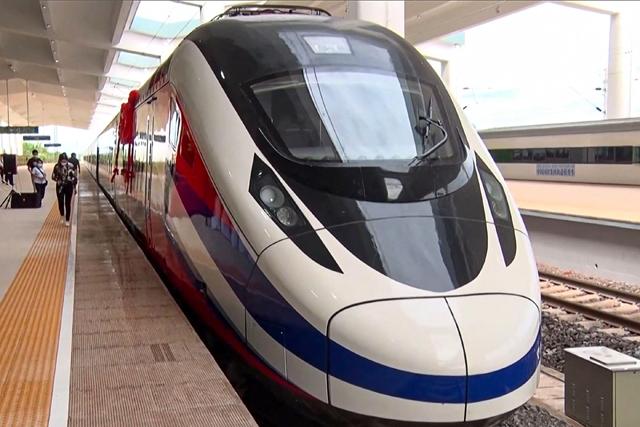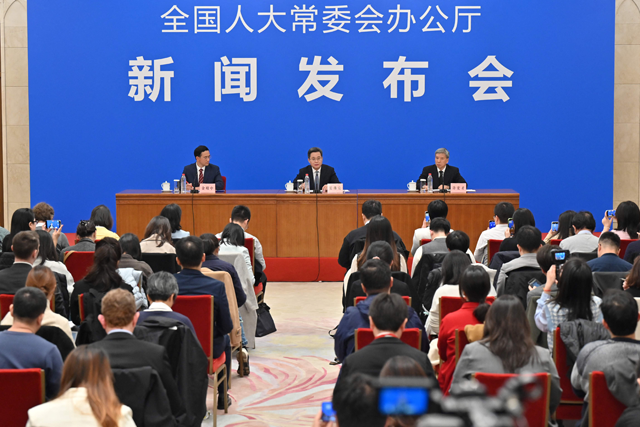You are here
Laos opens $6b rail link with China
By AFP - Dec 20,2021 - Last updated at Dec 20,2021

This file frame grab from Lao National TV video footage taken on October 16 via AFPTV shows the Lane Xang bullet train at the Vientiane Railway Station in Vientiane (AFP photo)
BANGKOK — Laos opened a new $6 billion rail link with China to much fanfare this month.
However, some analysts warn the party could be short-lived as the government grapples with a potential debt crisis.
The line will connect the capital Vientiane with the southern Chinese city of Kunming, and there are grand plans for a high-speed rail network running to Singapore through Thailand and Malaysia.
Laos President Thongloun Sisoulith at the opening heralded a "new era of modern infrastructure development" for the country, adding that "the dreams of Lao people have come true".
The government is hopeful the railway will turn a profit by 2027, but analysts are concerned about the unsustainable Chinese loans to pay for this and other projects.
With a tiny domestic market, there is "limited commercial logic for an expensive railway" to connect the country of seven million to Kunming, said Jonathan Andrew Lane in an Asian Development Bank Institute report.
His analysis found that potential benefits to Laos do not appear to outweigh the risks.
"That debt service will put further strain on the limited tax-raising abilities of the government," Lane wrote.
Laos faces having to stump up vast sums of cash to pay for the rail line, which was set up as a Laos-China joint venture under Beijing's vast, trillion-dollar Belt and Road infrastructure initiative (BRI).
As the reclusive Southeast Asian country's overall debt climbs to a dizzying $13.3 billion — making up almost three-quarters of gross domestic product (GDP) — experts fear Laos could be at risk of default.
That could bind it further to China, having already attracted the moniker "Chinese satellite state" — Beijing accounts for 47 per cent of its borrowings.
'Hidden debt'
Besides a $1.06 billion debt liability, Laos has exposed itself to so-called "hidden debt" in the formation of the joint venture to finance the railway, according to AidData, a research lab at American university William & Mary.
The tie-up comprises three Chinese state-owned companies and a Lao enterprise, with Beijing staking 70 per cent of the $3.54 billion debt.
Considered "too big to fail", researchers said there is some uncertainty over which country would feel compelled to bail out the joint venture if it defaulted.
If "insufficiently profitable, anywhere between 0-100 per cent of the total $3.54 billion debt could become a repayment obligation of the Government of Laos", AidData warned.
Another hidden debt is Laos' equity stake in the joint venture: A separate $480 million loan also financed by the Chinese — which suggests the tiny nation's asset "may be worthless", the lab added.
Laos's communist leaders have long tied the nation's economic development to its huge neighbour.
Between 2008-2019, it signed a total of $5 billion in Chinese loans for more than a dozen infrastructure projects — the lion's share spent on dams and hydroelectricity generation.
By August 2020, global credit agency Moody's downgraded the country's credit rating to junk status. Fitch Ratings followed soon after.
'What is the alternative?'
Laos Prime Minister Phankham Viphavanh — installed in March — hopes to reduce debt from 72 per cent to 64.5 per cent of GDP by the end of 2023.
But in the meantime, Laos owes $1.16 billion per year between 2022 and 2025, Fitch Ratings says.
Its public debt is higher than most regional counterparts — including Cambodia, Vietnam and the Philippines — which also have Chinese-financed infrastructure projects, according to the International Monetary Fund.
As of early 2021, Laos was "on the brink of sovereign default and urgently seeking debt relief from their Chinese creditors", AidData said.
But China is often reluctant to cancel BRI debts, instead offering deferrals — sometimes with higher interest rates — or rescheduled payment plans.
In September, Laos sold its electricity transmission grid to a Chinese state-owned enterprise for $600 million, an apparent debt-for-equity swap, according to researchers.
In August, Fitch said that further national assets sales are expected.
This trend has been seen in other Asian nations shouldering high Chinese debt.
One of the most prominent cases was Beijing's 2017 takeover of Sri Lanka's Hambantota port after the country was unable to repay a huge loan.
AidData said in September that BRI had saddled poor nations with "hidden debt" worth $385 billion, and more than a third of its projects were hit by alleged corruption and protests.
But while the outside world mulls whether China is taking over Laos, the Lowy Institute's Ben Bland said the impoverished state has little choice in its search for partners to grow its economy.
"What is the alternative? It doesn't seem that other foreign investment and development partners are eager to supplant China," he said.
Related Articles
BEIJING — China last week unveiled some of its most ambitious plans in years to lift local government debt and boost its economy, following
MAPUTO — The International Monetary Fund (IMF) on Monday said it was satisfied with the fiscal progress that Mozambique, ranked among the wo
BEIJING — Chinese President Xi Jinping on Monday said he hoped to broaden cooperation with Sri Lanka under his Belt and Road infrastructure













